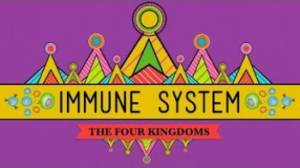Australian Water Dragons
Australian Water Dragons
The Australian water dragon (Intellagama lesueurii, formerly Physignathus lesueurii), which includes the eastern water dragon (I. l. lesueurii ) and the Gippsland water dragon (I. l. howittii ) subspecies, is an arboreal agamid species native to eastern Australia from Victoria northwards to Queensland. There may be a small introduced population on the south-east coast of South Australia.
The two subspecies tends towards white, yellow and red on the throat and possesses a dark band behind its eye; ”P. l. howitti” lacks this and instead has dark bands on either side of its throat, which is blotched with yellow, orange, or blue. Both subspecies are light greenish grey in overall colour with black bands running across their back, tail and legs.
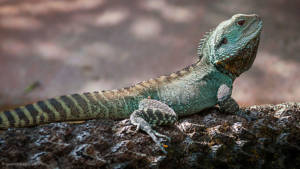
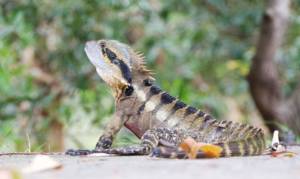
Behavior
Australian water dragons are extremely shy in the wild, but readily adapt to continual human presence in suburban parks and gardens. They are fast runners and strong climbers. When faced with a potential predator, they seek cover in thick vegetation, or drop from an overhanging branch into water. They are able to swim totally submerged, and rest on the bottom of shallow creeks or lakes for up to 90 minutes, to avoid detection.
Both males and females display typical agamid behaviour such as basking, arm-waving and head-bobbing. Fast arm-waving signals dominance, while slow arm-waving signals submission. Males are territorial, and in areas of higher population density, males exhibit displays of aggression toward other males including posturing and chasing.
Habitat
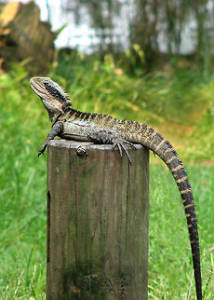
As its name suggests, the Australian water dragon is associated with water and is semi-aquatic.
It can be found near creeks, rivers, lakes and other water bodies that have basking sites such as overhanging branches or rocks in open or filtered sun. The species is so common in the rainforest section of Brisbane Botanic Gardens, Mount Coot-tha in Queensland that a monument has been built to them there.
There are anecdotal reports of a small colony living on the Sixth Creek in the Forest Range area of South Australia, which were probably introduced there during the 1980s by a local reptile enthusiast. This is many hundreds of miles outside their natural range.
Reproduction
Australian water dragons living in Australia climates hibernate over winter. During spring, usually in early October, the female excavates a burrow about 10–15 cm deep and lays between 6 and 18 eggs. The nest is usually in sandy or soft soil, in an area open to sun. When the mother has laid the eggs, she backfills the chamber with soil and scatters loose debris over it. Australian water dragons exhibit temperature defendant sex determination; the sex of the hatchlings is determined by the temperature of the nest site.
When the young are born they stay near the entrance of the burrow for some time before leaving home.
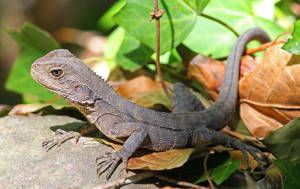
When they finally leave the nest, they tend to group together away from the adult population.
Food
Australian water dragons are prey to snakes, cats, dogs and foxes. Nestlings and smaller juvenile water dragons are vulnerable to predation by kookaburras, currawongs, butcherbirds and other carnivorous birds. They are also prone to becoming road kill due to the attraction of warm bitumen and concrete for basking.
The Australian water dragon’s diet depends on its size. Juveniles and yearlings tend to feed on small insects such as ants, spiders, crickets, and caterpillars. When they get bigger, so does their prey. An adult diet includes small rodents such as baby mice, although insects are still the most commonly consumed.
Predators
Australian water dragons are prey to snakes, cats, dogs and foxes. Nestlings and smaller juvenile water dragons are vulnerable to predation by kookaburras, currawongs, butcherbirds and other carnivorous birds. They are also prone to becoming road kill due to the attraction of warm bitumen and concrete for basking.
The Australian water dragon’s diet depends on its size. Juveniles and yearlings tend to feed on small insects such as ants, spiders, crickets, and caterpillars. When they get bigger, so does their prey. An adult diet includes small rodents such as baby mice, although insects are still the most commonly consumed.


